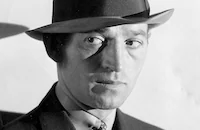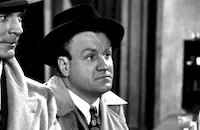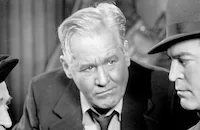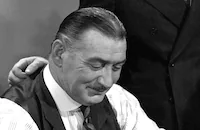One Mysterious Night

Brief Synopsis
Cast & Crew
Oscar Boetticher Jr.
Chester Morris
Janis Carter
William Wright
Richard Lane
George E. Stone
Film Details
Technical Specs

Synopsis
When the Blue Star of the Nile diamond is stolen from a jewel exhibit at the Carleton Plaza Hotel, Inspector Farraday publicly accuses reformed jewel thief Boston Blackie of the crime. Blackie, who along with his sidekick The Runt, is now legally employed at his friend Arthur Manleder's tool factory, takes umbrage at the accusation and pays the inspector a visit. At police headquarters, Farraday apologizes to Blackie and explains that he planted the story to entice Blackie to come to his office so that he could deputize him to recover the diamond. Accepting Farraday's assignment, Blackie visits the jewel exhibit disguised as elderly Professor Hunter and discovers a wad of chewing gum stuck underneath a display case. After learning that George Daley, the hotel's general manager, is in charge of the exhibit, Blackie searches Daley's office and finds a pack of chewing gum in his desk drawer. At that moment, Daley's sister Eileen, a switchboard operator at the hotel, enters the office, but is fooled by Blackie's impersonation. When Blackie goes to the hotel's concession counter to question the clerk, reporter Dorothy Anderson recognizes him and turns him over to the police. After Blackie instructs Farraday to notify the press that he has escaped from jail, he returns to the hotel, and now posing as Eileen's love-lorn suitor, learns her address. Meanwhile, at Eileen's apartment, George opens her dresser drawer and inspects the diamond, which he has hidden in her purse. Later, an unsuspecting Eileen decides to go out and takes her purse from the drawer. At that moment, Blackie rings the doorbell and accuses George of being involved in the robbery. After Blackie leaves, Eileen follows him, and George realizes that she has taken her purse with the diamond. Soon after, Paul Martens and Matt Healy, George's partners in crime, arrive at the apartment and demand the gem. When George tells them that Eileen has it, they warn him that they will return later that night. Meanwhile, Eileen has followed Blackie to a Chinese restaurant, where he shows her the wad of gum and explains his theory that George stole the stone by hiding it in the gum. Runt then warns Blackie that Dorothy is outside the restaurant, so Blackie tells Eileen to meet him later that night and disappears through a back door. Upon entering the restaurant, Dorothy follows Eileen to the powder room and surreptiously switches purses with her so that she can discover Eileen's name and address. When Eileen returns to her apartment, George grabs her purse and panics when he discovers that she has picked up the wrong bag. Soon after, Dorothy appears at the door to return Eileen's purse. After she leaves, Eileen finds the diamond and insists that George meet Blackie that night and give it back. Later on the street, as George hands the gem to Blackie, Martens and Healy pull up and demand the stone. In the ensuing struggle, George is shot and Martens forces Blackie and Runt into his car and speeds away. Dorothy witnesses the incident and reports that Blackie shot George, and as a result, Blackie is charged with George's murder. To insure that the police continue to believe that Blackie pulled the trigger, Martens takes him and Runt prisoner. To buy some time, Blackie tells Martens that the diamond is a fake and that the real gem is locked in the hotel safe. Martens and Healy decide to have the gem examined by Jumbo Madigan, the owner of a pawn shop, and after their captors leave, Blackie and Runt escape, and Blackie telephones Farraday to direct him to Madigan's shop. Meanwhile, at the shop, Jumbo is examining the stone when the doorbell rings, forcing Martens and Healy to hide in the back. Blackie tricks Martens and Healy into believing that he is a delivery boy and then tells Jumbo to claim that the diamond is fake and stall the thieves until the police arrive. Alerted by the sound of police sirens, Martens and Healy take Jumbo hostage, and when he resists, they shoot him. As the police burst into the shop, the thieves pose as mannequins until the officers leave. Believing that the diamond is a fake, Martens and Healy return to their apartment where Blackie and Runt, pretending to be their prisoners, offer to retrieve the real gem. When Martens insists on holding Runt hostage, Blackie goes to police headquarters and gives the diamond to Farraday, who then orders his assistant, Mathews, to organize a police dragnet around Martens' apartment building while he and Blackie return to the apartment. Upon their return, Martens and Healy tie them up and escape through the back door. After the police break down the apartment door, Blackie captures the thugs, and Farraday apologizes for misjudging his character. Dorothy then snaps their photograph for her newspaper, and Blackie chases her down the street.

Director

Oscar Boetticher Jr.
Cast

Chester Morris

Janis Carter

William Wright

Richard Lane

George E. Stone
Robert Williams
Robert E. Scott

Dorothy Maloney

Lyle Latell

George Mckay
Early Cantrell

Joseph Crehan
John Tyrrell
Ann Loos
Kenneth Brown
Billy Lenhart
Fred Graff
Pat O'malley
Cecil Weston
Edythe Elliott
Dick Jensen
George Magrill
Cy Malis
Ed Allen
Fred Howard
Ben Taggart
Jack Gardner

Ed Keane
Tom Kingston
Harrison Greene
Minerva Urecal
Henry Jordan
Constance Purdy
Almeda Fowler
Crew

Film Details
Technical Specs

Articles
One Mysterious Night
One of the first stars of the talking film era, Morris had been nominated for a Best Actor Oscar®, for Alibi (1929) at the third annual Academy Award race. He had also co-starred with Wallace Beery in MGM's seminal prison film, The Big House (1930). By the late '30s, however, he had moved into low-budget films, which made the security of Columbia's Boston Blackie series a very welcome thing.
He wasn't the screen's first Boston Blackie, however. Jack Boyle had introduced the character in the 1919 short story "Boston Blackie's Mary" as a hard-nosed prison inmate before featuring him in other stories as a warm-hearted thief. The character had appeared in a series of silent films starting in 1918, with Bert Lytell, who also had introduced the Lone Wolf to the screen, Lionel Barrymore and others. In 1941, Columbia dusted off the concept, turning Blackie into a wisecracking adventurer in Meet Boston Blackie. The film teamed Morris with Richard Lane, who would play his friendly nemesis in the police department, Inspector Farraday, in all 14 films. George E. Stone, an off-screen character who had become a friend of writer Damon Runyon while in vaudeville, joined the team as Blackie's sidekick, The Runt, in the same year's Confessions of Boston Blackie.
Columbia's Boston Blackie films were noted for their speed, the spirited playing of the leads and their often improbable plots, possibly made on the theory that if things moved quickly enough audiences wouldn't question such absurd developments as a pair of runaway crooks eluding the police by pretending to be tailor's dummies. They also were noted for showcasing young talent who would often go on to greater things at Columbia or other studios. Among the future names turning up in the series were director Edward Dmytryk and actors Larry Parks, Lloyd Bridges, Forrest Tucker, Steve Cochran, Nina Foch and Patricia Barry. In One Mysterious Night, Dorothy Malone (billed as Maloney), played an early role more than a decade before she would win an Oscar® for Written on the Wind (1956) or star in the first prime-time soap opera, Peyton Place.
The biggest new name in the film, however, was director Budd Boetticher, making his official directing debut with his given name, Oscar. After studying bullfighting in Mexico, Boetticher had gotten into films when his parents tried to save him from that dangerous occupation by getting him a job coaching Tyrone Power on his bullfighting moves in Blood and Sand (1941). He also helped choreograph Rita Hayworth's paso doble dance with Anthony Quinn. That led to other production jobs and a growing reputation for his ability to handle crowd scenes. He arrived at Columbia when director George Stevens requested him as an assistant director on The More the Merrier (1943). During production, Boetticher had a run-in with the studio's notoriously nasty head, Harry Cohn. When the younger man refused to give in to Cohn's bullying, the executive was impressed and put him under contract, saying, "Kid, I guess I'm the SOB who's going to have to make something out of you.".
Boetticher learned the ropes at Columbia by doing second unit work and producing. Then he got to fill in for Lew Landers directing scenes on the World War II thriller U-Boat Prisoner (1944). Cohn was sufficiently impressed to move him into the director's chair permanently with One Mysterious Night.
Although the move offered Boetticher a great opportunity, and he would go on to direct an acclaimed series of Westerns starring Randolph Scott in the '50s and '60s, the director never looked back on his first credited directing job with undue nostalgia. Years later, he told a film class at the University of Southern California that he started his career with a review that said, "This film wasn't released. It escaped." Several filmmakers have laid claim to that pan, but there's no question about the New York Times review, which labeled the film "as unsatisfying as a blank cartridge in a gunman's gat....much sound and very little fury."
Producer: Ted Richmond
Director: Budd Boetticher
Screenplay: Paul Yawitz
Based on the character created by Jack Boyle
Cinematography: L.W. O'Connell
Art Direction: Lionel Banks, George Brooks
Music: Mischa Bakaleinikoff
Cast: Chester Morris (Boston Blackie), Richard Lane (Inspector Farraday), Janis Carter (Dorothy Anderson), William Wright (Paul Martens), Robert Williams (Matt Healy), George E. Stone (The Runt), Dorothy Malone (Eileen Daley), Joseph Crehan (Jumbo Madigan).
BW-61m.
by Frank Miller

One Mysterious Night
Quotes
Trivia
Notes
The working title of this film was Boston Blackie's Appointment with Death. This picture marked Oscar "Bud" Boetticher's first assignment as a director. For additional information on the series, please consult the Series Index and see the entry above for Meet Boston Blackie.

Miscellaneous Notes
Released in United States Fall September 21, 1944
Released in United States Fall September 21, 1944













